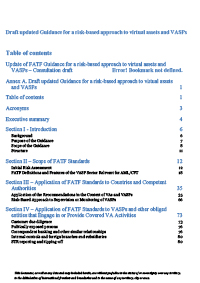The Financial Action Task Force (FATF) is updating its Guidance on the risk-based approach to virtual assets (VAs) and virtual asset service providers (VASPs). The FATF originally published this Guidance in June 2019 when the FATF finalised changes to its Standards to clearly place anti-money laundering and countering the financing of terrorism (AML/CFT) obligations on VAs and VASPs. In July 2020, the FATF committed to update this Guidance as set out in its 12-month review report and report to G20 on so-called stablecoins.
This revised document provides updated guidance in six main areas to (1) clarify the definitions of VA and VASP to make clear that these definitions are expansive and there should not be a case where a relevant financial asset is not covered by the FATF Standards (either as a VA or as a traditional financial asset), (2) provide guidance on how the FATF Standards apply to so-called stablecoins, (3) provide additional guidance on the risks and potential risk mitigants for peer-to-peer transactions, (4) provide updated guidance on the licensing and registration of VASPs, (5) provide additional guidance for the public and private sectors on the implementation of the ‘travel rule’ and (6) include Principles of Information-Sharing and Co-operation Amongst VASP Supervisors. The Guidance has also been updated to reflect the passage of time and the publication of other relevant FATF reports.
These changes to the FATF’s pre-existing Guidance aim to maintain a level playing field for VASPs, based on the financial services they provide in line with existing standards applicable to financial institutions and other AML/CFT-obliged entities, as well as minimizing the opportunity for regulatory arbitrage between sectors and countries.
The FATF is consulting private sector stakeholders before finalising the revisions to the Guidance. We welcome your views on the areas of focus below, in addition to specific proposals on the proposed revisions to the text of the Guidance. We primarily seek views from representatives from the VA community, including academics and policy bodies, VASPs, technology developers and providers (particularly in relation to the travel rule), other regulated entities (such as banks), but also welcome views from authorities.
Separate to this process, the FATF is also considering the implementation of the revised FATF Standards on VAs and VASPs, and whether further updates are necessary, through a second 12-month review. Relevant issues identified in this public consultation, which are outside the scope of this project, may be considered through that review. The FATF will consider the report of this review in June 2021.
| | Areas of focus
1. Does the revised Guidance on the definition of VASP (paragraphs 47-79) provide more clarity on which businesses are undertaking VASP activities and are subject to the FATF Standards?
- Is further guidance needed on how the FATF Standards apply to various business models, as stated in paragraphs 56-59? How should the Guidance further address the challenges in applying the definition of VASP to businesses which decentralize their operations across multiple parties?
- Is more guidance necessary on the phrase ‘for or on behalf of another natural or legal person’ in the FATF definition of VASP? What are the challenges associated with applying the business-customer relationship concept in the VASP context?
- Do the clarifications on the ‘expansive’ approach to the definition of VASP in identifying and policing the ‘regulatory perimeter’ for VASPs provide countries and the private sector with enough guidance? What additional clarity can be given to make the perimeter clearer?
2. What are the most effective ways to mitigate the money laundering and terrorist financing (ML/TF) risks relating to peer-to-peer transactions (i.e., VA transfers conducted without the use or involvement of a VASP or other obliged entity, such as VA transfers between two unhosted wallets) (see paragraphs 34-35 and 91-93)?
- How are peer-to-peer transactions being used for ML/TF purposes and what options are available to identify how peer-to-peer transactions are being used? What role and implications (e.g., benefits) do peer-to-peer transactions and unhosted wallets have in VA ecosystems?
- What specific options are available to countries and VASPs to mitigate the ML/TF risks posed by peer-to-peer transactions?
- Are the risk mitigation measures proposed in the Guidance in paragraphs 91-93 appropriate, sufficient and feasible?
3. Does the revised Guidance in relation to the travel rule need further clarity (paragraphs 152-180 and 256-267)?
- Are there issues relating to the travel rule where further guidance is needed? If so, where? Please provide any concrete proposals.
- Does the description of counterparty VASP due diligence clarify expectations, while remaining technology neutral and not prescribing how VASPs must undertake this process (see paragraphs 172-177 and 261-265)?
4. Does the revised Guidance provide clear instruction on how FATF Standards apply to so-called stablecoins and related entities (see Boxes 1 and 4 and paragraphs 72-73, 122 and 224)?
- Is the revised Guidance sufficient to mitigate the potential risks of so-called stablecoins, including the risks relating to peer-to-peer transactions?
5. Are there any further comments and specific proposals to make the revised Guidance more useful to promote the effective implementation of FATF Standards?
Please provide your response to FATF.Publicconsultation@fatf-gafi.org with subject-line “Comments of [author] on the draft revised VASP Guidance”, by 20 April 2021 (18:00 UTC). This public consultation is now closed.
|
While submitting your response, please indicate the name of your organisation, the nature of your business (VASP, technology provider, academic, policy body, other regulated entity), and your contact details. The contact information you provide will be used for the purpose of this public consultation only. The FATF will not share this information with third parties without your consent.
At this stage, the FATF has not approved the current draft of the guidance. The FATF will make further amendments at its June 2021 meetings.


 Twitter
Twitter
 Facebook
Facebook
 Instagram
Instagram
 Linkedin
Linkedin
